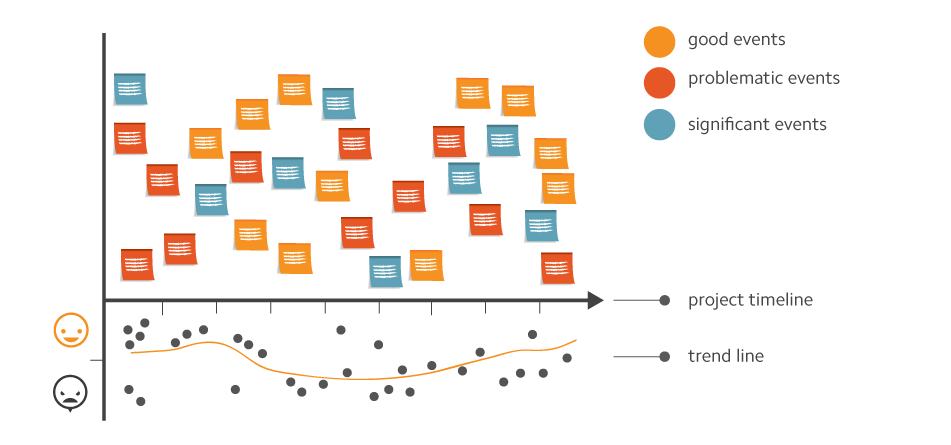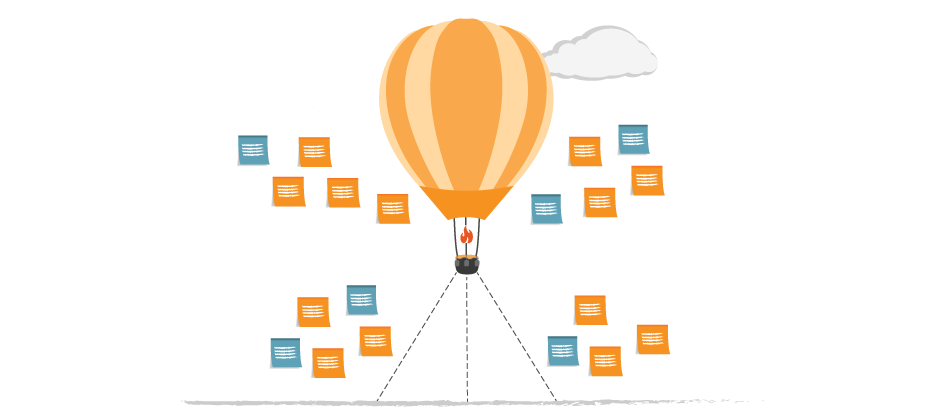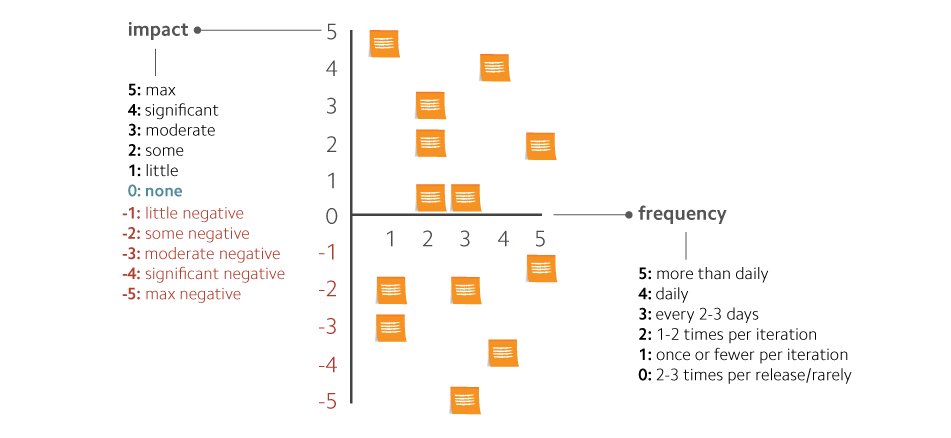Changing your Retrospectives format gives you new insights into your team and your project. It also revitalises common Agile ceremonies, which can start to feel like a chore if not given the time and attention they deserve.
So, without further ado, let’s get straight into some new formats to try next time your team runs a Retrospective.
Retro One: The emotional timeline

The “Emotional Timeline” (A.K.A Timeline Retro) format works great for reflecting on longer periods of time. It focuses on gathering data about events that have already occurred and engages the team’s emotional feeling in a single Retrospective.
Here’s how to run this Retro:
- Draw a timeline on a whiteboard
- Ask your team to write down on Post-it notes:
- Good events
- Problematic events
- Significant events
- Explain the events for context
- Everyone plots how happy or sad they were throughout the timeline
- Plot out the consensus line for the team
- Discuss the findings and identify actions for improvement in the future.
I’ve found this Retro format works well for reflecting over a few Iterations or months as opposed to a longer time period, where it can be much harder to remember what happened. I’ve had some great results facilitating it at approximately the 3-month marker of a project.
Tip: I’ve found providing some facts and figures at the start to jog people’s memories makes it better. Discuss facts and figures up front to help gather the events that occurred then look for further insight from the emotional state of the team. This can lead to identifying actions that would probably have been forgotten using any other technique.
Retro Two: Ropes and fuels

Benn Wheeler introduced to me this technique and I like its simplicity. Ropes and Fuels is similar to Speedboat1 – it also involves getting a team to help draw up various elements to start the activity. This one asks for reflection in just two areas:
- What holds us back? (Ropes)
- What’s pushing us forward towards our goals? (Fuels).
Here’s how to run this Retro:
- Ask the team to draw:
- A hot air balloon (the team)
- A flame (the fuel pushing us forward)
- The ropes (what is holding us back)
- Ask two team members to write down on Post-it notes:
- What’s holding the team back from achieving our goals?
- W hat’s pushing us forward towards our team goals?
- Briefly talk about each Post-it note for further clarity
- Use dot voting to determine what the team wants to discuss in order of priority
- Discuss the items in order of priority
- Identify actions for improvement in the future.
As indicated above, this Retro format is great because it’s both fun and simple. I find teams really appreciate the discussion and it can bring to light new project perspectives.
For example, this technique helped my team quickly realise that a lack of short-term planning was holding us back from achieving our goals because we weren’t clear on what to work on next. After spending quite a bit of time working out how we could improve on this, we identified some actions we could take to rectify the issue and move forward.
Retro Three: FRIM – FRequency/IMpact

This final format is called FRIM (short for FRequency & IMpact). It’s a technique that works well when you want to both:
- Understand what positive and negative things are happening within your team
- Understand how beneficial or painful these things are due to their frequency.
Here’s how to run this Retro:
- Draw a sideways T-shaped matrix on a whiteboard
- Ask the team to write down on Post-it notes those things that have a positive or negative impact on them
- Get each team member to place their Post-it notes on the board and use it to evaluate how frequently each impact happens
- Discuss the Post-it notes as a group. Start with the most frequent positive or negative impacts and work towards the opposite corner
- Identify actions for improvement in the future.
I’ve found this format works well during a regular Retrospective (i.e. at the end of a Retrospective). It highlights those really painful or positive things that occur and encourages a team to work constructively together to solve them or avoid them in the future.
Understanding if an impact is positive or negative and how frequently it occurs also gives you extra appreciation for what’s actually happening within your team.
Retrospectives – Mix ’em up
I firmly believe regularly changing the format of your team’s Retrospectives gives you new and valuable insights into an Agile project – and that can only prove productive!
Incorporate a creative/fun aspect by using the above techniques and you’ll have the added bonus of making these recurring ceremonies more refreshing. So get to it! It’s time to help the Retrospective strike back in your team!
References:
- Retrospective a fresh look, Ryan McKergow


